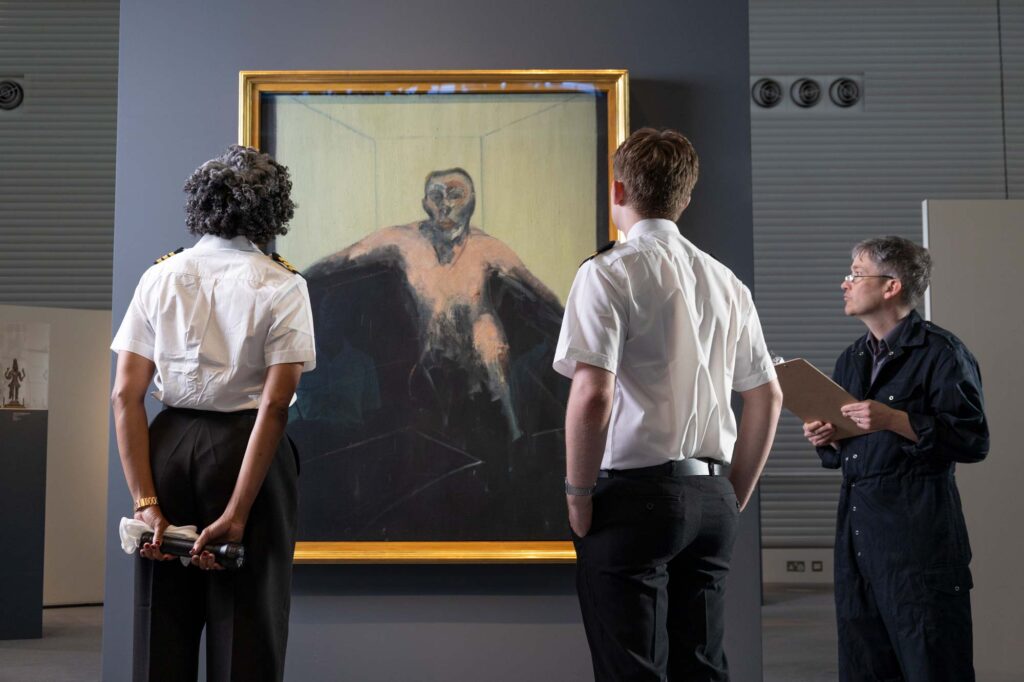Artworks go out on Day Release in Sainsbury Centre film project
More Information
Day Release, a new film project from the Sainsbury Centre sees well-known masterpieces of historic and modern art – including Francis Bacon’s portrait of his lover, Peter Lacy, and Henry Moore’s Mother and Child (1932) – leave the confines of the museum and go out into the world, exploring how society has transformed since they were first created. The films are illustrative of the Sainsbury Centre’s belief that all art is alive and that, rather than being inanimate objects, each artwork has a personal story and lifeforce of their own.
The Day Release series of dramatic, short, scripted films explore themes of identity and belonging, social inequality and opportunity, and ask how the power of an artwork can influence how people understand the world around us and the impact of time passing since an artwork’s creation.
Episode 1, features Francis Bacon’s painting, Study for Portrait of P.L., no. 2 (1957) and is available to view here/above on the Channel and on the Sainsbury Centre YouTube Channel.
Francis Bacon’s painting, Study for Portrait of P.L., no. 2 (1957), a portrait of his lover, Peter Lacy, revisits Bacon’s old haunt, the Colony Room Club in London’s Soho, where the pair first met and where the painting meets a young man struggling to be openly affectionate with his boyfriend in public. The film explores how society has changed for the LGBTQ+ community since the painting was last in Soho in the 1950s.
Episode 2 – coming soon – follows Henry Moore’s Mother and Child (1932) sculpture going on day release to a children’s playground. Set in Castleford, the artist’s birthplace, the film echoes how art enabled Moore, the son of a coal mining family from this location to break generational social structures. This story plays out the life of a teenager living there today who feels tied to home due to her caring duties for her mum, and her encounter with an older female stranger, who also acts as a carer for her elderly mother. As Moore’s Mother and Child watches on, these stories of old and new barriers to social mobility in Henry’s hometown play out. Moore described his mother as an “un-resting source of stability and protection”, with his earliest memory being rubbing oil into her back and, drawing on this memory, the film explores how art can enable people to forge their own path.
The Sainsbury Centre’s Living Art programme invites visitors to meet art held in the museum’s collections in new and more emotional ways. To move beyond traditional ways of looking at art, to experiment with finding new ways to connect with and experience artworks in order to bring the power of that relationship to life. In both Day Release films, the artwork forms the third character in the interactions which play out on screen. Its presence sparks a conversation between the characters, demonstrating the power of art to change lives.
Jago Cooper, Director of the Sainsbury Centre said, “Taking art out of the museum to where it might actually want to be for the day, totally changes how that work can be experienced and understood today. It enables you to instantly recognise how society either has or hasn’t changed since the emotional power of that work was materialised half a century ago. Luckily for Francis Bacon’s painting of Peter Lacy, you can still find a fantastic pub in Soho to hang out.”
Supported by The Estate of Francis Bacon.
With special thanks to Colony Room Green by Darren Coffield for Daisy Green Collection.

Credit: On set of Day Release. Featuring: Francis Bacon, Study for Portrait of P.L., no. 2, 1957, oil on canvas. © The Estate of Francis Bacon. All rights reserved / DACS. Photograph: Kate Wolstenholme